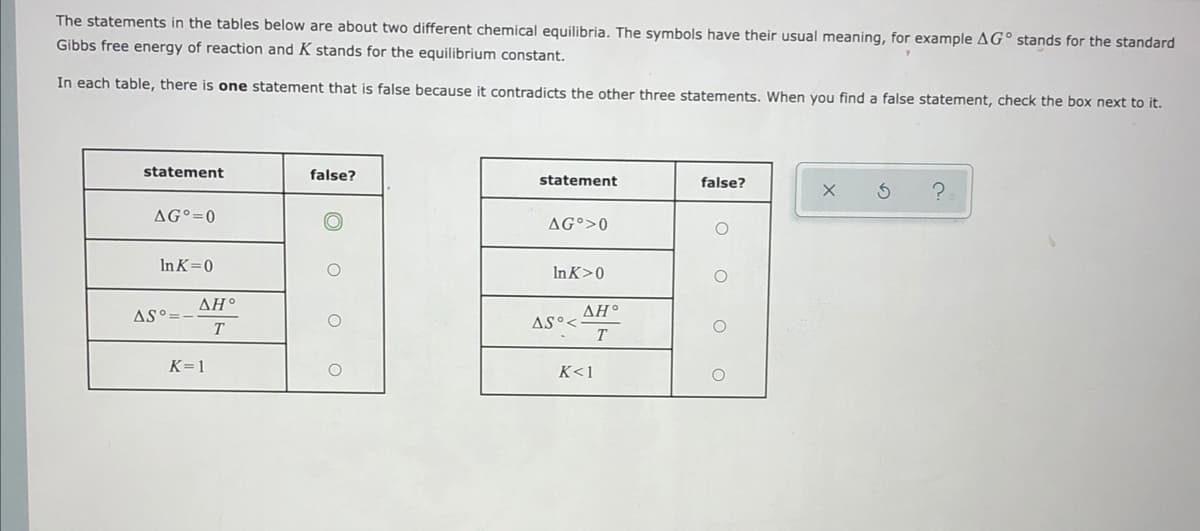tables belów are about two different chemical equilibria. The symbols have their usual meaning, for example AG° stands for the standard Gibbs free energy of reaction and K stands for the equilibrium constant. In each table, there is one statement that is false because it contradicts the other three statements. When you find a false statement, check the box next to it. statement false? statement false? AG°=0 AG°>0 In K=0 InK>0 ΔΗ AS°=- ΔΗΟ AS°< T. T K=1 K<1
tables belów are about two different chemical equilibria. The symbols have their usual meaning, for example AG° stands for the standard Gibbs free energy of reaction and K stands for the equilibrium constant. In each table, there is one statement that is false because it contradicts the other three statements. When you find a false statement, check the box next to it. statement false? statement false? AG°=0 AG°>0 In K=0 InK>0 ΔΗ AS°=- ΔΗΟ AS°< T. T K=1 K<1
General Chemistry - Standalone book (MindTap Course List)
11th Edition
ISBN:9781305580343
Author:Steven D. Gammon, Ebbing, Darrell Ebbing, Steven D., Darrell; Gammon, Darrell Ebbing; Steven D. Gammon, Darrell D.; Gammon, Ebbing; Steven D. Gammon; Darrell
Publisher:Steven D. Gammon, Ebbing, Darrell Ebbing, Steven D., Darrell; Gammon, Darrell Ebbing; Steven D. Gammon, Darrell D.; Gammon, Ebbing; Steven D. Gammon; Darrell
Chapter18: Thermodynamics And Equilibrium
Section: Chapter Questions
Problem 18.124QP: Hydrogen gas and iodine gas react to form hydrogen iodide. If 0.500 mol H2 and 1.00 mol I2 are...
Related questions
Question

Transcribed Image Text:The statements in the tables below are about two different chemical equilibria. The symbols have their usual meaning, for example AG° stands for the standard
Gibbs free energy of reaction and K stands for the equilibrium constant.
In each table, there is one statement that is false because it contradicts the other three statements. When you find a false statement, check the box next to it.
statement
false?
statement
false?
AG°=0
AG°>0
In K=0
InK>0
ΔΗ.
ΔΗ.
AS°=
AS°<
T
K=1
K<1
Expert Solution
This question has been solved!
Explore an expertly crafted, step-by-step solution for a thorough understanding of key concepts.
Step by step
Solved in 2 steps with 1 images

Knowledge Booster
Learn more about
Need a deep-dive on the concept behind this application? Look no further. Learn more about this topic, chemistry and related others by exploring similar questions and additional content below.Recommended textbooks for you

General Chemistry - Standalone book (MindTap Cour…
Chemistry
ISBN:
9781305580343
Author:
Steven D. Gammon, Ebbing, Darrell Ebbing, Steven D., Darrell; Gammon, Darrell Ebbing; Steven D. Gammon, Darrell D.; Gammon, Ebbing; Steven D. Gammon; Darrell
Publisher:
Cengage Learning

Chemistry: The Molecular Science
Chemistry
ISBN:
9781285199047
Author:
John W. Moore, Conrad L. Stanitski
Publisher:
Cengage Learning


General Chemistry - Standalone book (MindTap Cour…
Chemistry
ISBN:
9781305580343
Author:
Steven D. Gammon, Ebbing, Darrell Ebbing, Steven D., Darrell; Gammon, Darrell Ebbing; Steven D. Gammon, Darrell D.; Gammon, Ebbing; Steven D. Gammon; Darrell
Publisher:
Cengage Learning

Chemistry: The Molecular Science
Chemistry
ISBN:
9781285199047
Author:
John W. Moore, Conrad L. Stanitski
Publisher:
Cengage Learning


Chemistry: An Atoms First Approach
Chemistry
ISBN:
9781305079243
Author:
Steven S. Zumdahl, Susan A. Zumdahl
Publisher:
Cengage Learning

Chemistry
Chemistry
ISBN:
9781305957404
Author:
Steven S. Zumdahl, Susan A. Zumdahl, Donald J. DeCoste
Publisher:
Cengage Learning

Principles of Modern Chemistry
Chemistry
ISBN:
9781305079113
Author:
David W. Oxtoby, H. Pat Gillis, Laurie J. Butler
Publisher:
Cengage Learning